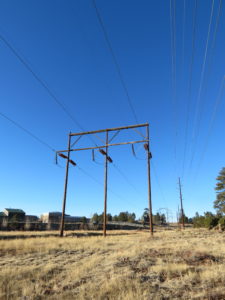 I dressed in layers and packed my knapsack until it was bursting. Too much water and not enough sunscreen, I would later learn on the trail—and that I probably never need to bring a paperback bird guide with me again as long as I have the eBird app on my phone.
I dressed in layers and packed my knapsack until it was bursting. Too much water and not enough sunscreen, I would later learn on the trail—and that I probably never need to bring a paperback bird guide with me again as long as I have the eBird app on my phone.
At the end of January, I decided to go on my first bird watching hike through Picture Canyon. I didn’t know what to expect from the three-hour hike and imagined that, in the throes of winter, the watch party might include just me and the guide and no one else. But birders are a hardy crew, and our group of 14 was ready to hit the trail just after sunrise. Part of going out on a bird hike was to learn more about bird watching from an experienced guide, but I also wanted to learn some new-to-me trails, and about the nature preserves in and around Flagstaff.
I wondered about this place being so close to the mall and auto park, and then wondered about a handful industrial buildings to the right of the trail. “Waste water treatment plant,” our guide cheerfully noted. As she took us down the trail, I couldn’t help but notice the treatment plant abutted the Rio de Flag as well as a wetlands area where we stopped to admire several kinds of ducks. Our guide was keen to find a hooded merganser, but I was keen to know more about this wetland so close to the treatment facility. The ducks didn’t seem to mind.
As we continued our walk, it was hard not to notice the towering power lines running parallel to the trail. I knew they were safe—they must be, right? The electrical hum was loud and made me curious about sparks that might hit these grasslands. Would there be enough water to quench a subsequent fire? And would a spark start from a lightning strike during monsoon season, or some random time of the year when the air holds that particular kind of static electricity? As I took photos of the powerlines bisecting the clear blue sky, I assured myself that there must be some kind of lightning strike preparedness out here. I then chastised myself for taking photographs of the lines rather than birds and hustled to catch up with the group.
The trails of Picture Canyon are fairly wide and clearly marked. After a while I noticed small red reflective arrows nailed into the trunks of various pines, which must be the reason everyone in our party except for me seemed to know the way. I imagined the paw prints in the dried mud of the trail as those belonging to a wolf, only to later encounter an overly-friendly dog who pranced around our group, seemingly happy to have found his pack. Once in a while, I imagined myself living near the beautiful stream in these flat grasslands of the canyon—until I saw the signs: non-potable water, private land, no trespassing, beware.
People on the hike walked next to me and tried to start conversations—where was I from? When did I become interested in birding?—but I was unable to keep up my end of the conversation as I tried to take note of where I was on the trail and read all of the trail signs. Eventually I found myself walking slightly behind the group and on the lookout for petroglyphs. After about an hour, we found the glyphs, clearly marked, with interpretive signs explaining the possible date of the artwork, the meanings of the glyphs and information about the people who used to live in this region. Since we were on the hike to observe birds, we quickly left the petroglyphs behind.
The more I looked for signs to guide my walk, the more I found them. A sign explaining the remains of a railroad trestle over the waterfalls. A sign indicating the importance of the wetland region to our mountain desert. A sign with images of birds I might see on this trail. A sign marking the end of the trail. Another private property, no trespassing sign.
On this day I had dedicated to observing nature, I instead saw how much we interpret and interrupt nature. Of course I wanted to know more about the petroglyphs, but I wondered instead about checking a book out from the library and learning more deeply about the indigenous people of this region rather than relying on a quick gleaning of information from signs.
As I balanced my camera on the private property fence post to take a photograph of a red-tailed hawk, I realized that, even in my eagerness to witness nature, there was a dual compunction to also own a piece of nature. To ensure that I could name this bird and take a photograph of it high in the crook of a pine tree. And then to share the photo later as a badge of having communed with nature, however fleetingly. Just by being here, I was interrupting nature and wondered what right I had to even be in this place.
Toward the end of the outing I fell into walking with a gentleman who wasn’t much for talking either, which suited me. Instead, we would quietly wait for each other to catch up from taking a photo or looking through our respective binoculars. As we finished the hike, he finally spoke. “I wonder if the birds are scared off by all of the noise,” he said. Instead of responding, I stood next to him and listened. I heard the crackle and buzz of the powerlines, the repeated bleats of a truck in reverse, workers at the waste treatment plant shouting greetings to one another and the footsteps of our party crunching along gravelly trails as they walked ahead, searching for, and finally finding, the merganser.

